
I. Introduction
In-text citations are a crucial aspect of academic writing, serving as a way to give proper credit to sources, avoid plagiarism, and help readers locate the original source of information. Among citation styles, MLA is one of the most widely used formats, making it essential for any student or researcher to understand how to cite in-text properly in MLA style.
II. Components of an MLA In-Text Citation
In an MLA in-text citation, the author’s last name and the page number of the source are included in parentheses after a quote or paraphrase. For example, (Jones 23) would indicate that the information came from page 23 of a source written by an author named Jones. Make sure to place the citation in the correct location in the sentence, such as after the author’s name or at the end of the quote.
III. Examples of Different Types of Sources
In-text citations are required for any source used in academic writing, including books, articles, and websites. For a book, the citation would look something like this: “According to Jones, the sky is blue” (23). For an article, it would be: “The study found that dogs can reduce stress” (Smith 9). With a website, the citation should include the author’s name, the title of the page or article, and the date of publication, like this: “In a recent article, Johns stated that the economy is improving” (Johns, “Economic Update”).
IV. Common Mistakes Made in MLA In-Text Citations
One of the most common mistakes made in an MLA in-text citation is forgetting to include the page number for a source. This can be easily corrected by double-checking the citation to ensure all required components are present. Other mistakes may include misspelling an author’s name, failing to include the author’s name altogether, or misplacing the citation within the sentence.
V. How to Create an In-Text Citation in MLA Format
The process of creating an in-text citation in MLA format can be broken down into several steps:
- Identify the source type (book, article, website, etc.)
- Find the necessary information (author’s name, page number, publication date, etc.)
- Place the citation in the correct location in the sentence
- Ensure proper capitalization and punctuation
- Double-check the citation for accuracy
VI. Tips for Integrating In-Text Citations into Writing Smoothly
One way to use in-text citations smoothly is to incorporate signal phrases that introduce a quote or paraphrase, such as “According to Jones” or “In a study by Smith.” Transitions can also be used to flow between quotes and paraphrases more easily, keeping writing coherent and easy to read. It’s essential to make sure that in-text citations don’t disrupt the flow of writing and fit naturally into the text.
VII. Conclusion
Overall, understanding MLA in-text citation is essential for anyone engaged in academic writing. Knowing how to create a proper in-text citation, avoiding common errors, and making the citation fit naturally into the writing can go a long way toward improving the quality and accuracy of a research paper or essay. By following the tips outlined in this guide, students and researchers can ensure that they create an effective and proper in-text citation in MLA format.





